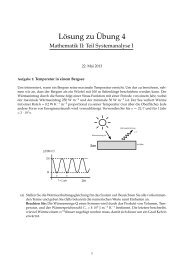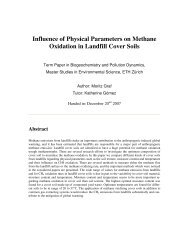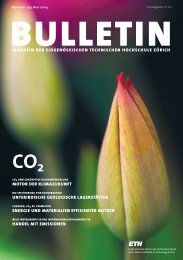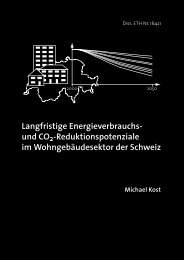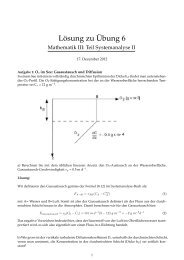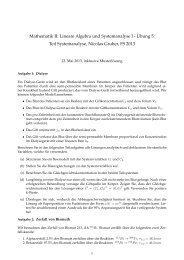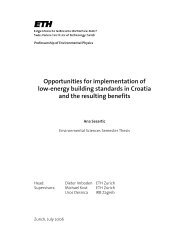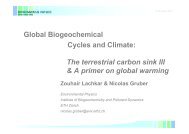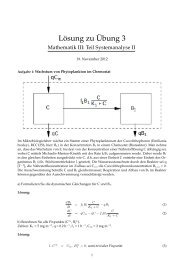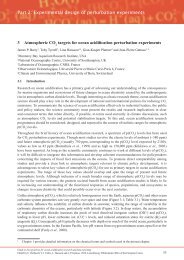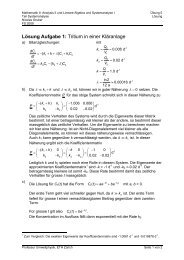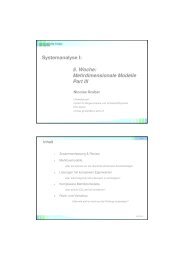Tutorial 4 - ETH - UP - Environmental Physics - ETH Zürich
Tutorial 4 - ETH - UP - Environmental Physics - ETH Zürich
Tutorial 4 - ETH - UP - Environmental Physics - ETH Zürich
Create successful ePaper yourself
Turn your PDF publications into a flip-book with our unique Google optimized e-Paper software.
Global Biogeochemical <br />
<br />
Cycles and Climate: <br />
<strong>Tutorial</strong> 4: Terrestrial<br />
Carbon Cycle<br />
Meike Vogt<br />
<br />
<strong>Environmental</strong> <strong>Physics</strong> <br />
Institute of Biogeochemistry and Pollutant Dynamics<br />
<strong>ETH</strong> Zürich<br />
meike.vogt@env.ethz.ch<br />
1
The unperturbed terrestrial carbon cycle<br />
INTRODUCTION<br />
( -1 yr (Units: Reservoirs in Gt C, Fluxes in Gt C<br />
> Terrestrial biosphere: 5 times more carbon than the atmosphere (but<br />
about 10 times less than the ocean) à changes in terrestrial carbon<br />
storage directly and immediately impact atmospheric CO 2<br />
> Residence time (τ = Mass / Flux):<br />
τ for photosynthesis / respiration cycle of living biomass ~ 11 years<br />
compared to ~1 month for marine biota, although similar fluxes<br />
2<br />
(2004 (SCOPE, Sabine et al.
Exchanges between biosphere and atmosphere<br />
INTRODUCTION<br />
Momentum<br />
Radiation<br />
Precipitation<br />
Deposition<br />
NH4<br />
NO3<br />
SO4<br />
O3<br />
ATMOSPHERE<br />
Sensible Heat<br />
Latent Heat<br />
Trace Gases<br />
CO2<br />
CH4<br />
N2O<br />
Key Characteristics<br />
Leaf Area<br />
Sensible Heat<br />
(Roughness) Surface Height<br />
Albedo<br />
Soil moisture<br />
Nutrients<br />
TERRESTRIAL ECOSYSTEMS<br />
> Impact the global water cycle and albedo thus energy balance<br />
(chemistry > Impact the composition of the atmosphere (GHGs,<br />
> Impact the momentum transfer<br />
3<br />
TUTORIAL 4
Outline<br />
OUTLINE<br />
• Introduction: Overview Pool Sizes and Fluxes<br />
• What limits terrestrial NPP?<br />
• Major Biomes of the World<br />
• Carbon Storage on Land<br />
• Impact of a Changing Climate?<br />
4<br />
TUTORIAL 4
Global Net Primary Production (NPP) 2001/02<br />
PRODUCTIVITY<br />
5<br />
http://earthobservatory.nasa.gov/Newsroom/NPP/npp.html
What limits terrestrial productivity?<br />
PRODUCTIVITY<br />
Main factors limiting terrestrial biological productivity:<br />
• water availability<br />
• temperature conditions<br />
• light conditions<br />
• availability of nutrients<br />
• CO 2 concentration<br />
Differences to marine biological productivity?<br />
(Fe) à macro nutrients (N, P, Si), light, temperature, micro nutrients<br />
6<br />
TUTORIAL 4
Global rainfall patterns<br />
PRODUCTIVITY<br />
7<br />
TUTORIAL 4
Global pattern of surface temperature<br />
PRODUCTIVITY<br />
8
(PAR) Global pattern of “available radiation”<br />
PRODUCTIVITY<br />
9<br />
(2005) Raschke and Ohmura
Photosynthetically available radiation (PAR)<br />
PRODUCTIVITY<br />
Solar radiation spectrum<br />
Energy for photosynthesis<br />
comes<br />
essentially from the blue and<br />
red wavelengths<br />
Blue: 475 nm<br />
Green: 510 nm<br />
Yellow: 570 nm<br />
Red: 625 nm<br />
10
Nitrogen limitation<br />
PRODUCTIVITY<br />
Ratio of nitrogen availability over nitrogen demand (NCAR CCSM)<br />
70%<br />
75%<br />
Many regions are nitrogen limited.<br />
11 Thornton pers. Comm.
Global Net Primary Production (NPP) 2002<br />
PRODUCTIVITY<br />
12<br />
http://earthobservatory.nasa.gov/Newsroom/NPP/npp.html
Outline<br />
OUTLINE<br />
• Introduction: Overview Pool Sizes and Fluxes<br />
• What limits terrestrial NPP?<br />
• Major Biomes of the World<br />
• Carbon Storage on Land<br />
• Impact of a Changing Climate?<br />
13<br />
TUTORIAL 4
Terrestrial biomes<br />
BIOMES<br />
> Classification of biomes: structural and functional different ecosystem<br />
complexes exist under different climate/environmental conditions, i.e.,<br />
biomes are distinguished primarily by their predominant plants and are<br />
associated with particular climates<br />
> usually between 15 and 20 biome types (depending on the<br />
(included classificaton; the 8 major biomes are ~consistently<br />
> Distribution of biomes: along latitudes; but impacted by topography,<br />
ocean/land distribution, etc.<br />
14<br />
(1996) Adapted from: H.J. de Blij and P.O. Miller
Terrestrial biomes<br />
BIOMES<br />
15<br />
(1996) Adapted from: H.J. de Blij and P.O. Miller
Terrestrial biomes and temperature/precipitation<br />
BIOMES<br />
> Temperature and precipitation limit the distribution of plant communities<br />
16<br />
http://www.globalchange.umich.edu/globalchange2/current/2007/Labs/Unit-203b2007_files/image004.jpg
Outline<br />
OUTLINE<br />
• Introduction: Overview Pool Sizes and Fluxes<br />
• What limits terrestrial NPP?<br />
• Major Biomes of the World<br />
• Carbon Storage on Land<br />
• Impact of a Changing Climate?<br />
17<br />
TUTORIAL 4
Carbon storage in terrestrial biomes<br />
CARBON STORAGE<br />
( -2 m C density (kg<br />
Plant Soil<br />
20 11.7<br />
16 13.4<br />
9 20.6<br />
0.3 20.4<br />
? ?<br />
0.5 6.0<br />
1.8 4.2<br />
0.7 18.9<br />
0.3 5.8<br />
> Differences between biomes generally account for large parts of the<br />
spatial variability of carbon storage<br />
18<br />
(2004 (SCOPE, Sabine et al.
Production terms: GPP, NPP, NEP, and NEE<br />
CARBON STORAGE<br />
GPP: Gross primary production<br />
NPP: Net primary production<br />
NEP: Net ecosystem production<br />
NEE: Net ecosystem exchange<br />
NPP = GPP - R a<br />
NEP = NPP - R h<br />
NEE = NEP - disturbance = NPP - R h - disturbance<br />
19<br />
TUTORIAL 4
CARBON STORAGE<br />
What determines NEE? Balance of assimilation/respiration<br />
Respiration vs Transpiration<br />
20<br />
TUTORIAL 4
Carbon storage in terrestrial pools<br />
CARBON STORAGE<br />
> Carbon storage are largest in the equatorial, innertropic ecosystems and<br />
at high northern latitudes<br />
21<br />
http://soils.usda.gov/use/worldsoils/mapindex/
Vegetation carbon<br />
CARBON STORAGE<br />
22<br />
> Vegetation carbon: high values in the inner tropics, elevated at mid to<br />
high northern latitudes<br />
http://soils.usda.gov/use/worldsoils/mapindex/
Soil carbon<br />
CARBON STORAGE<br />
> Soil carbon: largest values at high northern latitudes<br />
23<br />
http://soils.usda.gov/use/worldsoils/mapindex/
Outline<br />
OUTLINE<br />
• Introduction: Overview Pool Sizes and Fluxes<br />
• What limits terrestrial NPP?<br />
• Major Biomes of the World<br />
• Carbon Storage on Land<br />
• Impact of a Changing Climate?<br />
24<br />
TUTORIAL 4
Impact of climate change<br />
CC IMPACT<br />
R a<br />
Rh<br />
Climate change can alter all fluxes through different mechanisms:<br />
- warmer temperatures: enhance NPP, but also enhance R h<br />
- wetter/drier: enhance/reduce NPP, but also alter R h .<br />
- length of the growing season<br />
- frequency of extreme events (fires,…): alter the disturbance flux<br />
- changes in cloudiness: alter the PAR, hence GPP<br />
25
Impact of climate change on vegetation<br />
Based on NCAR CCSM simulation<br />
CC IMPACT<br />
Bala et al, 2005<br />
26
Impact of climate change on land carbon stocks<br />
CC IMPACT<br />
Based on NCAR CCSM simulation<br />
1870-2100<br />
27<br />
http://www.nesl.ucar.edu
Terrestrial biosphere: future CO 2 sink or source?<br />
CC IMPACT<br />
Potential feedback mechanisms:<br />
- CO 2 increase: increase in CO 2 assimilation<br />
+ Temp increase: increased plant/soil respiration<br />
+/- Climate change: changes in vegetation structure<br />
(2001) al. Hypothesis by Joos et<br />
Slow warming: negative feedbacks will be dominant (sink<br />
( 2 of atmospheric CO<br />
Fast warming: positive feedbacks will be dominant (source<br />
(atmosphere of CO 2 to the<br />
28<br />
TUTORIAL 4
Terrestrial biosphere: future CO 2 sink or source?<br />
CC IMPACT<br />
Prescribed<br />
atmospheric CO 2<br />
Modelled terrestrial<br />
CO 2 Source/Sink<br />
29<br />
(2001) al. Joos et
Terrestrial biosphere: future CO 2 sink or source?<br />
CC IMPACT<br />
30<br />
(2001) al. Joos et
Outline of BGC&Climate course<br />
OUTLINE COURSE<br />
31<br />
TUTORIAL 4
INTRODUCTION<br />
The terrestrial carbon cycle and atmospheric CO 2<br />
Photosynthesis<br />
Respiration<br />
32<br />
(2005 CDIAC (Trends
NPP and Evapotranspiration<br />
PRODUCTIVITY<br />
33<br />
TUTORIAL 4
Impact of climate change on vegetation<br />
CC IMPACT<br />
Based on NCAR CCSM simulation<br />
Bala et al, 2005<br />
34
Vegetation changes 2100 - 1765<br />
FEEDBACKS<br />
35<br />
(2001) al. Joos et
Changes in carbon storage 2100 - 1765<br />
CC IMPACT<br />
release uptake<br />
36<br />
(2001) al. Joos et



